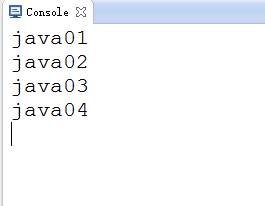Home >Java >javaTutorial >Detailed explanation of List collection and its traversal in Java
Detailed explanation of List collection and its traversal in Java
- 高洛峰Original
- 2017-01-22 15:35:261983browse
1. First of all, the List
① Collection (the collection framework appeared in JDK1.2 version)
② list: It is ordered, and the elements can be repeated, so the collection system has an index.
Often used are the ArrayList and LinkedList classes that implement this interface
③ Arraylist: The underlying data structure uses an array structure,
Features: Query speed is very fast , but additions and deletions are slightly slower. Threads are not synchronized
LinkedList: The bottom layer uses a linked list data structure.
Features: The addition and deletion speed is very fast, and the query is slightly slower.
Vector: (Appeared in JDK1.0 version) The bottom layer is an array data structure and thread synchronization. Replaced by ArrayList. (No longer used)
2. Two traversal methods for List:
public class Demo {
public static void main(String[] args) {
ArrayList<String> list = new ArrayList<String>();
list.add("A");
list.add("B");
list.add("C");
System.out.println("........第一种遍历方式:for遍历......");
for (Object li : list) {
System.out.println(li);
}
System.out.println("........第二种遍历方式:ListIterator迭代遍历......");
ListIterator<String> it = list.listIterator();
while (it.hasNext()) {
Object obj = it.next();
System.out.println(obj);
}
}
}
Rendering:

3. Use LinkList to simulate a stack or queue data structure. That is: Stack: first in, last out; Queue: first in, first out
class Duilie{
private LinkedList<Object> link;
Duilie(){
link = new LinkedList<Object>();
}
public void myAdd(Object obj){
link.addFirst(obj);
}
public Object myGet(){
return link.removeLast();//先进先出---若要改成先进后出,将removelast()改成removeFirst()
}
public boolean isNull(){
return link.isEmpty();
}
}
public class Demo2 {
public static void main(String[] args) {
Duilie dl = new Duilie();
dl.myAdd("java01");
dl.myAdd("java02");
dl.myAdd("java03");
dl.myAdd("java04");
while(!dl.isNull()){
System.out.println(dl.myGet());
}
}
}
Rendering:

The above is first in, first out. If you want to change it to first in, last out, just change it according to what is written in the code.
The above is the entire content of this article. I hope you all like it.
For more detailed explanations of List collections and their traversal in Java, please pay attention to the PHP Chinese website!

